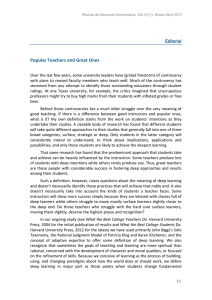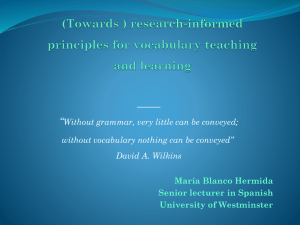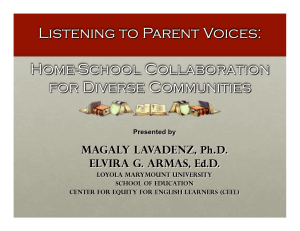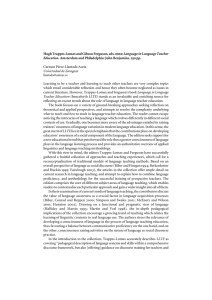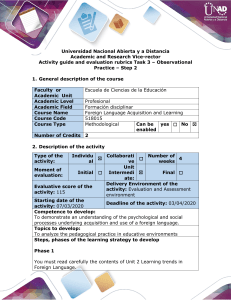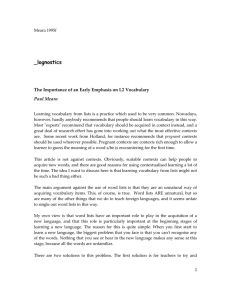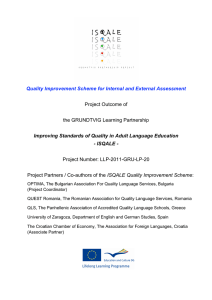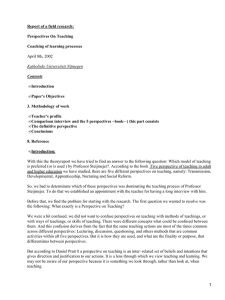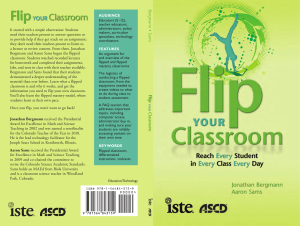NaturalApproachofTeachingEnglishLanguageonaFlippedClassroomPlatformtoTertiaryLevelEngineeringLearners PraveenSamD
Anuncio
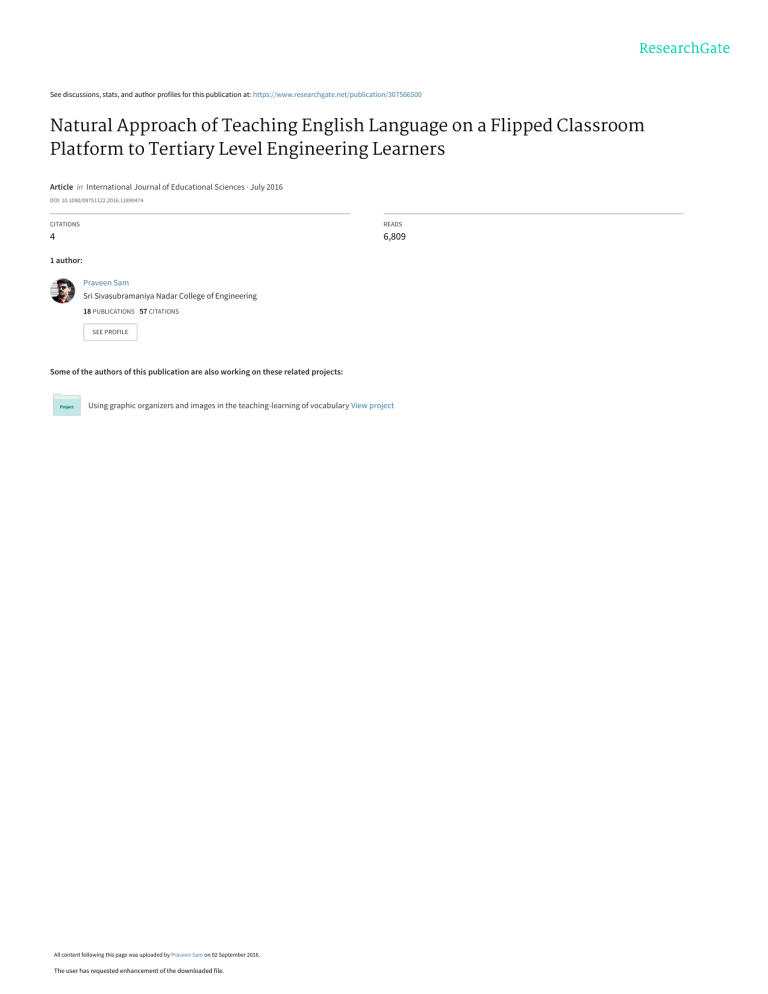
See discussions, stats, and author profiles for this publication at: https://www.researchgate.net/publication/307566500 Natural Approach of Teaching English Language on a Flipped Classroom Platform to Tertiary Level Engineering Learners Article in International Journal of Educational Sciences · July 2016 DOI: 10.1080/09751122.2016.11890474 CITATIONS READS 4 6,809 1 author: Praveen Sam Sri Sivasubramaniya Nadar College of Engineering 18 PUBLICATIONS 57 CITATIONS SEE PROFILE Some of the authors of this publication are also working on these related projects: Using graphic organizers and images in the teaching-learning of vocabulary View project All content following this page was uploaded by Praveen Sam on 02 September 2016. The user has requested enhancement of the downloaded file. © Kamla-Raj 2016 Int J Edu Sci, 14(1, 2): 13-18 (2016) Natural Approach of Teaching English Language on a Flipped Classroom Platform to Tertiary Level Engineering Learners D. Praveen Sam Department of English, SSN College of Engineering, Chennai 603 110, Tamil Nadu, India KEYWORDS Approaches to English Language Teaching. English as Second Language. Models of Learning. Post Secondary Level Learners ABSTRACT There are various approaches and methods to teach English language in the second language context. Teachers of this language apply different methods convenient or suitable for the learners’ specific requirements. Natural approach is one of the approaches used in tertiary level where learners are provided with opportunities to acquire language rather than forcing it on learners by emphasizing the language forms. The flipped classroom model forms an effective platform applying natural approach in the teaching-learning process. This paper presents a process for using natural approach in the flipped learning platform and pedagogical implications of applying natural approach in teaching English language to tertiary level engineering learners in a flipped model. INTRODUCTION In the current day educational scenario, technology plays an integral role in the process of teaching and learning at the tertiary level. Also, it has brought about fundamental changes in mode and technique of teaching and learning. Conventionally, learning was a concept dealt with inside a classroom, whereas in the current educational scenario, space and time are no more limitations to learning. One of the challenges being faced by the language teachers at higher education level is how to influence the learners’ interest and experience of technology in fulfilling the learning outcomes of a course. In the engineering context, in terms of the language learning, learners are instrumentally motivated. They approach English language as a tool that impacts the placement process and also beyond placement processes in their career. This means that incorporating technology to develop the learners’ language competence should be equally proportional to objective attached to learning English language. Jonathan and Aaron (2013) decided to use screen-capturing software to record introductory lessons and have students learn their lesson at home by watching or reading materials that were screen-captured. The students would then use class time for more constructive activities. This is the birth of a model of learning called flipped learning. They believed that using the classroom alone for teaching learners was inadequate, whereas learning and student participation should be within and without classroom. This idea of learning within and without the classroom should help students display higher-order skills proficiently, but classrooms based teaching prepares students only to take tests and examinations (Roehl et al. 2013). The foremost objective of teaching English language to the students is the develop them to handle real life situations in their career and also in their social life. Therefore, shifting language learning from the classes to the masses is the need of the hour. According to Boucher et al. (2013), in a classroom, the time allotted for teaching language has to be utilized in different ways in terms of the flipped model. The issue of using time differently in this model is not for the sake of changing but it is associated with many improvements in the levels of learning and teaching, that is, more time to interact and clarify the text, more time to discuss ideas deeply, and more time for additional inputs on the materials used for learning and practice with active learning methodologies. The next very important aspect of teaching and acquiring English language skills is the approach adapted by the teachers to teach the language to the learners. In this context, natural approach of teaching English language is explored. This approach was formulated by Tracy Terrell, a Spanish teacher, based on Krashen’s model of second language acquisition. This paper sheds light on the modalities of using natural approach in the flipped learning platform. It also presents the pedagogical implications of this model. 14 Objectives of the Study The objectives of this study are: • To enhance the English language teaching-learning process by incorporating natural approach and mapping it with the flipped classroom model. • To help teachers understand the effectiveness of applying a natural approach to teaching English language in the flipped classroom model. • To create a process for using natural approach in the flipped learning platform. Flipped Learning Model The term ‘flipped classroom’ is commonly defined as watching pre-recorded lectures online. However, this generalization results in the lack of understanding of this new paradigm. Flipped model is a learner-centered learning environment rather than teacher-centered one. The Flipped Learning approach allows teachers to implement a methodology, or various methodologies, in their classrooms. In the learner-centered classroom, learners approach learning by sharing responsibility in terms of their learning. They become more engaged in the learning process compared with the teacher-centered classrooms. This typically means that learners are introduced to content outside of classroom, which enables them to come to the class prepared and participate in the activities designed by the teachers. D. PRAVEEN SAM The Flipped Learning Network (FLN) has defined this concept as a pedagogical approach where the learning space is shifted from group learning inside the classroom to individual learning without limiting to the classroom. This results in a dynamic and interactive learning environment for students to collaborate, where teachers moderate students as they apply concepts and engage creatively in the learning process. Flipped Classroom and Flipped Learning The terms Flipped Classroom and Flipped Learning are interchangeably used, whereas they differ in the contextual meanings. Flipping a class can, but does not necessarily lead to Flipped Learning (FL). Having students read text, watch audio-video materials, solve activities outside of class, maybe in computer lab or at their homes online or offline, seems to be a flipped model, but to engage in flipped learning, teachers must make sure that the learning environment is flexible, as teachers often physically rearrange their learning spaces to conduct group or individual activities. Unlike the traditional teacher-centered model where the teacher is the primary source of information, the flipped classroom model shifts to a learner-centered approach, and the activities inside the classroom are meant to discuss and explore the topics in depth, and these activities also help students in knowledge construction (Fig.1). Teachers following Flipped Learning repeatedly think about how they can put flipped learn- Fig. 1. Traditional vs Flipped learning model -classroom Source: Author NATURAL APPROACH OF TEACHING ENGLISH LANGUAGE ing model to a variety of use to help students develop theoretical understanding, as well as process of the activities they take part (Bergmann and Sams 2012). They decide what is to be taught and what materials should be explored by the students on their own. The Natural Approach to Teach English Language Learning is one of the important everyday encounters for everyone, but it is most obvious for young learners who rapidly attain new behaviors, data, languages, ideas and concepts (Bartsch et al. 2003). One of the main objectives of learning a language is to produce ideas and communicate them using that language. Moreover, language is viewed as a vehicle for communicating messages and meaning. According to Krashen (1983), acquisition takes place only when listener understands the message in the target language. When it comes to teaching of the English language, there are different schools of thought depending on the kinds of requirement. Some advocate methods intensify grammar teaching and drilling, some without giving prominence to grammar teaching, some advocate activity-based teaching and so on. Young learners tend to learn language more implicitly rather than explicitly (Cameron 2001; Pinter 2006; Slatterly and Willis 2001). A Spanish teacher named Tracy Terrell in California, USA, advocated an approach to teaching of language, which was different from grammar translation method and other methods existed for teaching language in the 1970s. He based this approach on the use of language in communicative situations and without reference to grammatical drilling or grammatical analysis. According to Widdowson (1978), overemphasis on grammatical correctness and rules would result in prevention of the learners from developing their communicative competence. He then collaborated with Stephen Krashen from University of Southern California to intricate the theoretical based and called this the natural approach of teaching language. There is common assumption amidst teachers and learners that natural approach and natural method are synonymous to each other. Although there are certain common elements in both, there are some important differences between natural approach and natural method. The 15 Natural Method is another term for what in the course of time had become known as the Direct Method. However, the natural approach is a language teaching approach, which claims that as native language is acquired by the students, target language should also be learnt in a natural way. The approach holds on to a communicative approach to language teaching. Unlike the direct method, however, the natural approach gives less emphasis on teacher talking for a long time, making students repeat what the teachers’ say, and limiting the questions to the textbook alone, and more importantly, less focus on accuracy in terms of target language sentences (Richards and Rodgers 1986). In the natural approach, the teacher uses the target language to communicate in the classroom, whereas students can use either the language being taught or their mother tongue. The errors students commit during communication are not corrected by stopping them abruptly, but activities are framed based on the errors they commit and administered outside the classroom as homework. Application of Natural Approach in a Flipped Model: Pedagogical Implications In accordance with comprehensible input hypothesis advocated by Krashen, students learn a language only when it is understandable to them. Natural approach is designed based on the idea that language learning takes place only when the students understand the language and not by mere grammatical analysis of the language. Therefore, the learning situation should consist of facilities where students could take part in authentic conversations, which is possible only when they go beyond the classroom. In this way, students are aware that they are using their English language to communicate, but they acquire language indirectly and also unnoticed (Krashen 1983). Classroom is a place where students participate in activities based on the learning outcomes, and their performance should be monitored by the teacher and given apt feedback. According to low affective filter, students acquire language when they are not stressed and having fun. Methods of language teaching based on natural approach utilize teaching strategies that reduce affective filter automatically (Krashen 1981). As classroom is a serious place and students 16 D. PRAVEEN SAM are pressurized with several things. They cannot be relaxed and have fun inside the classroom. On the other hand, students are relaxed when they are outside the classroom. Therefore, the flipped model suggests that students learn or explore content, which is identified by the teacher outside the classroom using a computers, laptops, palmtops, smartphones, and so on, and inside the classroom, they perform and participate in activities designed by the teachers. The Figure 2 represents the process involved using natural approach in the flipped learning platform. The following are the pedagogical implications of applying the natural approach in the flipped learning platform: Learning takes place within and without the classroom. In the course of learning outside the classroom, students participate in a self organized learning environment (SOLE), where they learn in their own pace, and they collaborate with the peers face-to-face and online. While exploring content on a particular topic or an idea, students collaborate via social networking websites and mobile applications. Students are introduced to the topic and learning outcomes Teachers identify adequate online resources (Websites, podcast, videos and so on) related to the topic The identified resources are made available to the students (through email, WhatsApp, fb and so on) Outside Classroom Students access the resources online Students discuss the resources with the teacher online (through social networking forums like WhatsApp group and so on) Within Classroom Teachers prepare activities based on the resources Students participate in the activities in the classroom Teachers monitor the performance of the students and give individual feedback and record the progress Fig. 2. Process: Using natural approach in the flipped learning platform Source: Author 17 NATURAL APPROACH OF TEACHING ENGLISH LANGUAGE Students not only surf the Internet for information but also use libraries, meet experts in the field of study, participate in online forums and so on. In the course of communication with people outside the classroom, students tend to produce language in an authentic context. And they indirectly use and learn language in a socio-cognitive perspective. Students design learning strategies on their own in course of exploring materials/contents outside the classroom context. Students verify their ideas and information they have accumulated outside the classroom by participating in various activities in the classroom. Teachers administer activities in the classroom and monitor the progress of the students. Teachers could give individual feedback to the students, after the class hours, through email or other mobile applications such as WhatsApp, Viber and so on. DISCUSSION The objective of any method or model of teaching the English language is to equip students with adequate competence in using the language. The flipped classroom can clearly be a successful model, and as teachers and students become more comfortable with the concept, it may become a standard. As the natural approach is based on activities and a student centric atmosphere inside and outside the classroom, flipped classroom serves as an effective model. To work effectively in this model, teachers will have to play the role of a moderator. In a traditional classroom, students get information only from the teacher and they often try to incarcerate what the teacher is saying once or twice. They do not have an option of accessing the information again outside the classroom, and also they might miss important points. On the contrary, the use of online materials such as podcasts, video and other content that students can access outside the classroom help them in better learning. CONCLUSION There are various methods and approaches, which are being used in the process of language teaching and learning. Flipped classroom is one such model, which has grown in popularity and effectiveness across disciplines and levels. The unique features of this method are about taking learning beyond the classroom context, variety of activities in the classroom, collaborative teaching and learning and so on. Likewise, natural approach of teaching English language is an effective approach, which advocates for an idea of learning language naturally and more importantly, without much emphasis on grammar. This study proposes a modality with the combination of natural approach and flipped classroom model for teaching English language. Also, a process chart for the application of this method has been proposed for the teacher. They can use it as it is or alter it suiting their classroom context. RECOMMENDATIONS Incorporation of natural approach for teaching of English language in a flipped model is a modality discussed in the paper. The following are the recommendations based on the study: Teachers of the English language should incorporate methods, which enable the students to extend learning beyond the classroom. A variety of materials should be used in the course of learning along with the textbook as a supplementary source of information. Teachers should shift from lecture methods to a collaborative way of teaching involving students. REFERENCES Bartsch K, Keith JH, Estes D 2003. Young children’s talk about learning events. Cognitive Development, 18: 177–193. Bergmann J, Sams A 2012. Flip Your Classroom: Reach Every Student in Every Class Every Day. Alexandria, Washington DC: ASCD: International Society for Technology in Education. Boucher B, Robertson E, Wainner R, Sanders B 2013. “Flipping” Texas State University’s physical therapist musculoskeletal curriculum: Implementation of a hybrid learning model. Journal of Physical Therapy Education, 27(3): 72-77. Cameron L 2001. Teaching Languages to Young Learners. Cambridge: Cambridge University Press. Krashen S 1981. Second Language Acquisition and Second Language Learning. Oxford: Pergamon Press. Pinter A 2006. Teaching Young Language Learners. Oxford: Oxford University Press. 18 Richards JC, Rogers TS 1986. Approaches and Methods in Language Teaching: A Description and Analysis. Cambridge, UK: Cambridge University Press. Roehl A, Reddy SL, Shannon G 2013. The flipped classroom: An opportunity to engage millennial students through active learning strategies. Journal of Family and Consumer Sciences, 2(105): 44-49. View publication stats D. PRAVEEN SAM Slatterly M, Willis J 2001. English for Primary Teachers. Hong Kong: Oxford University Press. Widdowson H 1978. Teaching Language as Communication. Oxford: Oxford University Press. Paper received for publication on February 2016 Paper accepted for publication on July 2016
